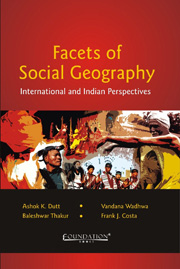Book contents
- Frontmatter
- Contents
- Foreword
- Preface
- Acknowledgements
- List of Contributors
- I Introductory Framework: Allen G. Noble's Contribution to Social Geography
- II Conceptual and Theoretical Basis of Social Geography
- III Social Geography from a Global Perspective
- IV Social Geography in the Indian Context
- 15 Socio-cultural Regions in Pre-historic and Historic India
- 16 Distinct Regional Cultural Identities of India Based on Religion and Language
- 17 Linguistic Diversity Changes in India: A Regional Analysis, 1971–2001
- 18 The Geography of Folk Art in India
- 19 Indian Dance: Classical Unity and Regional Variation
- 20 Space, Gender and Social Value: Analyzing Gender Inequalities in Relation to Space
- 21 Encountering Reservation and the Reimagining of Caste
- 22 Spatial Patterns of Crime in India
- 23 Rural Human Resource Development in India: A Spatio-Temporal Analysis
- V Indian Social Geography: City and State Context
- Index
15 - Socio-cultural Regions in Pre-historic and Historic India
from IV - Social Geography in the Indian Context
Published online by Cambridge University Press: 05 June 2012
- Frontmatter
- Contents
- Foreword
- Preface
- Acknowledgements
- List of Contributors
- I Introductory Framework: Allen G. Noble's Contribution to Social Geography
- II Conceptual and Theoretical Basis of Social Geography
- III Social Geography from a Global Perspective
- IV Social Geography in the Indian Context
- 15 Socio-cultural Regions in Pre-historic and Historic India
- 16 Distinct Regional Cultural Identities of India Based on Religion and Language
- 17 Linguistic Diversity Changes in India: A Regional Analysis, 1971–2001
- 18 The Geography of Folk Art in India
- 19 Indian Dance: Classical Unity and Regional Variation
- 20 Space, Gender and Social Value: Analyzing Gender Inequalities in Relation to Space
- 21 Encountering Reservation and the Reimagining of Caste
- 22 Spatial Patterns of Crime in India
- 23 Rural Human Resource Development in India: A Spatio-Temporal Analysis
- V Indian Social Geography: City and State Context
- Index
Summary
Geographical factors provide the stage for cultural groups to work out their destinies and establish distinctive occupancy patterns. The evolution of cultural regions, emergence of cultural cores, and the direction and speed of cultural diffusion are greatly controlled by the prevailing geographical conditions of a region. Thus, the historical experiences of the people living in different geographical regions have been strikingly different. Such a situation is more marked in countries like India where the large areal extent, vast physical diversity and unique geographical location have made it a known case of unity in diversity in terms of the cultural pattern.
The physical framework of the Indian subcontinent determined the initial migration routes as well as the choice of the settlement area (river valleys or interfluvial tracts) by the incoming cultural streams originating from different parts of Asia. The scarcity of food and the presence of natural barriers, such as rivers, hill ranges, or desert expanses curbed their freedom of movement. Over the wide open valleys and the undulating plains on the plateau, they could also perceive social barriers erected along the contact lines between different ethnic groups and enforced by social customs. It may be assumed that the primeval culture domains were ethnically homogeneous and socially defined as their violation invited conflict, followed by internecine wars. Initially, there was a remote possibility of cultural overlap. Subbarao (1958, pp. 8–35) used detailed archaeological data to demonstrate the preservation of mutual exclusiveness in the remote hill tracts.
- Type
- Chapter
- Information
- Facets of Social GeographyInternational and Indian Perspectives, pp. 263 - 293Publisher: Foundation BooksPrint publication year: 2012

